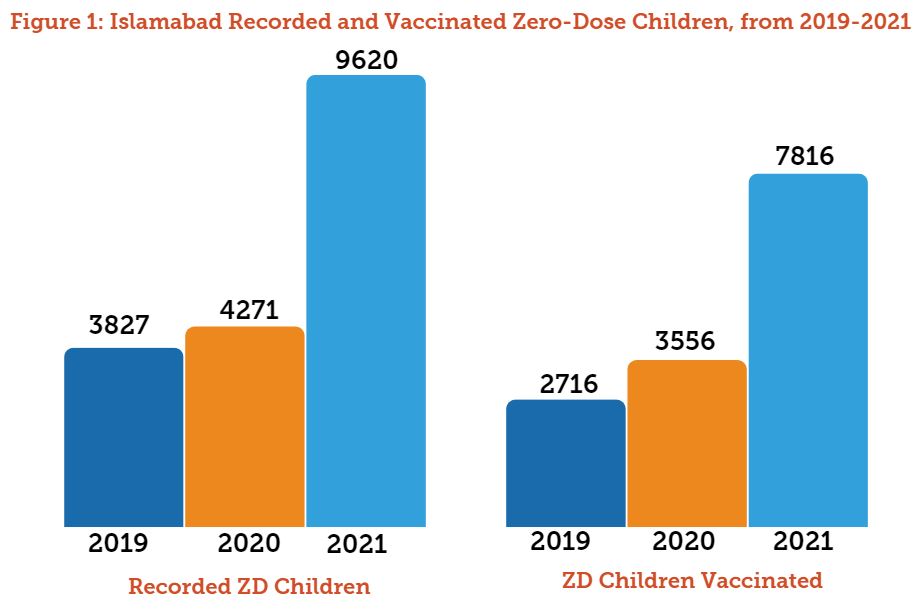Catching-Up in Islamabad: Identifying and Reaching Zero-Dose Children Following the COVID-19 Pandemic
In May 2022, Sabin’s Boost Community and the World Health Organization (WHO) launched the first cohort of the "COVID-19 Recovery for Routine Immunization Programs Fellowship". The aim of this program was to strengthen the capacity of national and sub-national immunization professionals to plan and implement immunization programming during the COVID-19 recovery period, with the ultimate goal of reversing the declining rates of immunization coverage. After an intensive live engagement series, Fellows were tasked with drafting their own strategic proposal for implementation or case study for publication. This series of Bright Spots that shares Fellows' key learnings and takeaways from the program.
Routine Immunization (RI) stands as a critical pillar in preventing numerous infectious diseases, stopping potential outbreaks, and reducing child morbidity and mortality. However, the impact of the COVID-19 pandemic on the healthcare system has caused disruptions in immunization services globally, resulting in a significant increase in zero-dose (ZD) children – those who have not received any life-saving vaccinations.
As one of the nations grappling with the highest number of ZD children, even before the COVID-19 pandemic, Pakistan continues to face challenges in closing this gap. The urban landscape of Islamabad, with a population of more than two million people, faces substantial and unique challenges, largely due to the number of urban slums. The interruption of polio campaigns had a two-fold effect – not only did it hinder polio vaccination efforts for children born during the pandemic, but it also interrupted tracking ZD children which was generally conducted during polio campaigns. The limited resources available for both routine and supplementary immunization activities remains a significant challenge in the effort to reach ZD children, though as routine immunization activities resumed, supplementary polio activities have worked hard to catch-up and vaccinate ZD children.

Recording and reporting ZD children is critical to ensure that every child receives life-saving routine immunization (RI). This study seeks to examine the variation in the number of ZD children recorded in Islamabad from 2019 to 2022 (before, during, and after the pandemic). Furthermore, this study also explores the efforts made by health authorities to vaccinate reported ZD children, in support of identifying potential interventions to maximize the coverage.
Intervention
During Polio Supplementary Immunization Activities (SIA), frontline teams go door-to-door to vaccinate children with the oral poliovirus vaccine (OPV), focusing only on administering OPV. In addition, frontline teams inquire about vaccination status of all children in each household. This data is recorded and shared with their supervisors, facilitating the tracking of these children for routine immunization and the monitoring of ZD children. To ensure comprehensive coverage, field supervisors validate the data collected and share the list of ZD children with the district health authority.
The data collected by frontline teams during SIAs is initially recorded in tally sheets, and then consolidated at the Union Council level, and shared with District and Province respectively. This information is then shared with vaccinators at Union Council level, who use this list to reach these ZD children and administer age-appropriate vaccines via fixed site and during outreach sessions. As the majority of the frontline Polio teams are CHVs in Islamabad, these volunteers continue to play a major role in mobilizing children to vaccination sites and educating the parents about the importance of RI and scheduled vaccination sessions within the area.

Recording and reporting ZD children is critical to ensure that every child receives life-saving routine immunization (RI). This study seeks to examine the variation in the number of ZD children recorded in Islamabad from 2019 to 2022 (before, during, and after the pandemic). Furthermore, this study also explores the efforts made by health authorities to vaccinate reported ZD children, in support of identifying potential interventions to maximize the coverage.
Results
The number of recorded ZD children increased by 444 children between 2019 to 2020, from 3,827 in 2019 to 4,271 in 2020, reflecting the closure of outpatient departments during the pandemic. Insights from interviews with Assistant Supervisor Vaccinators (ASVs) and District Superintendent Vaccinators (DSVs) in Islamabad revealed that after resuming vaccination services in the district, the vaccinators and community health workers followed the ZD children for immunization at the outreach sessions. This rigorous follow-up and extensive vaccination efforts contributed to a substantial increase in recorded ZD children to 9,620 in 2021.
However, despite health authorities being able to identify ZD children, they were able to vaccinate an average of 81.24% of recorded ZD children in 2021, with 18.76% of recorded ZD children remaining unvaccinated at the end of 2021. The health delivery system is still recovering from delays caused by the COVID-19 pandemic. Moreover, guest children from other districts are also recorded as ZD but may not be vaccinated because of their short stay.
| Islamabad Zero-Dose Campaign Data, from 2019-2021 | ||||||
|---|---|---|---|---|---|---|
| 2019 | 2019 | 2020 | 2020 | 2021 | 2021 | |
| Campaigns | Recorded ZD Children | Vaccinated ZD Children | Recorded ZD Children | Vaccinated ZD Children | Recorded ZD Children | Vaccinated ZD Children |
| 1st Campaign | 828 | 515 | 965 | 901 | 1579 | 1356 |
| 2nd Campaign | 1131 | 789 | 1660 | 1408 | 1641 | 1370 |
| 3rd Campaign | 665 | 420 | 1646 | 1247 | 1289 | 1082 |
| 4th Campaign | 1203 | 992 | - | - | 1745 | 1363 |
| 5th Campaign | - | - | - | - | 1830 | 1511 |
| 6th Campaign | - | - | - | - | 1536 | 1134 |
| Total | 3827 | 2716 | 4271 | 3556 | 9620 | 7816 |
Lessons Learned

The COVID-19 pandemic had a significant impact on routine immunization services in Islamabad. The significant increase in ZD children demonstrates the reduction in RI-seeking behavior due to fear of COVID-19 in the initial days of the pandemic; low coverage rates can also be attributed to lockdowns; travel bans and closure of health facilities. The data also reflects newborns added to the cohort of ZD children who did not receive their first dose of any vaccines.
Interviews suggested that the persistent gaps observed during district monitoring, despite the resumption of outreach sessions, can be attributed to several factors – the unavailability of the male family member (head of the house), lack of knowledge about the vaccination activity and their location, and personal commitments. Islamabad’s geography further exacerbates these challenges as all major government hospitals are located in the central area, with few small healthcare centers in the periphery, requiring many parents to travel far for vaccination and treatment. Furthermore, females are unable to travel alone to immunization centers without male companions; as no government centers provide services during the evening hours, working males found it difficult to accompany their partners for vaccination appointments.

As shared by the ASVs and DSVs, SIAs are the sole strategy to identify ZD children in Islamabad, as they are the only extensive activity on a large scale where frontline teams access every household. Once a child receives vaccination, it can be followed for the rest of routine immunization activities. Community mobilization, with the help of teams and lady health workers (LHWs), play a vital role in the coverage of ZD children.
Looking Forward

Comprehensive RI services require an increase in human resources, including more female vaccinators, and higher frequency of outreach sessions. Moreover, establishing a RI/EPI center at each Mother Child Health Centers, increasing the number of fixed vaccination sites, and expanding services to include evening hours would enable the health system to leverage every opportunity to vaccinate children for RI. Making Measles and Penta vaccines available at every major hospital that vaccinates at least 100 children a day would further minimize vaccine wastage and maximize coverage.
Communication, social mobilization and community involvement are key for the success of increasing vaccine coverage. Though conducting activities during SIAs has been successful, sharing information with local and out of district guests is of utmost importance. By enhancing the role of social mobilizers to share information regarding planned outreach sessions and vaccination activities, communication with parents will be strengthened. Announcements can be shared in areas which hold religious or social gatherings, such as mosques. An SMS service to remind parents of their child’s next vaccination appointment would additionally support the reduction of under-vaccinated children.

Finally, to ensure every child is covered, registration of pregnant females during their hospital visits or with the help of LHWs can support record keeping of who to send RI services to post-partum. Antenatal and postnatal counseling of mothers about the importance of RI and providing them with the information about their nearest vaccination centers will also continue to make an impact on vaccine coverage and prevent future ZD children.
References
- Bhatt, M. Waqar. “ Pakistan has largest number of ‘zero-dose’ children: WHO.” the News Pakistan |the News International, 15 July 2023, https://www.thenews.com.pk/print/1090659-pakistan-has-largest-number-of-ZD-children-who
- Islamabad. (n.d.). Retrieved from City Population: https://www.citypopulation.de/en/pakistan/admin/islamabad/501_islamabad/
- Immunization. (2022, July). Retrieved from UNICEF: https://data.unicef.org/topic/child-health/immunization/
- Immunization Dashboard. (2022). Retrieved from WHO: https://immunizationdata.who.int/

2022 Fellow / Contributor
This study is shared by Reham Baig, MD, MPH. A public health professional with over five years of experience in surveillance and immunization in Pakistan. She works as a Disease Surveillance Officer for the World Health Organization (WHO) in Islamabad. She is committed to addressing these gaps through community education and engagement, enhancing routine immunization, and addressing religious and cultural barriers to vaccination. Dr. Baig provides technical support in surveillance of VPDs (Vaccine Preventable Diseases), outbreak investigation and Routine Immunization.



